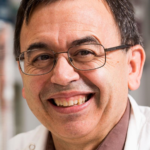From London Labs to Global Growth: the Abzena Story

Successful university spinout companies are a key feature of the UK’s economic landscape – but not many can match the remarkable rise of Abzena, a thriving life sciences business at the arrow tip of medical innovation.
From its origins in cross-institutional research at the London School of Pharmacy (now part of UCL) and Imperial College London, to the launch of spinout PolyTherics and its evolution into Abzena, this is a story of how great science and commercial vision have led to new therapies targeting cancer, macular degeneration and other serious conditions.
But this is also a tale where close, mutually beneficial ties between industry and academia are continuing to underpin the success of a multinational company firmly established as a global force in the field of biopharmaceuticals.
Flashback: First Steps
“Our mission? To help translate leading-edge research from lab bench to clinical use,” explains John Burt, Abzena’s CEO. “We provide technological and manufacturing know-how crucial to developing and delivering life-changing, life-saving therapies.”
So how did the company, which now has a presence in key pharmaceutical hubs on both east and west coasts of the US, an impressive array of international partners and a customer base spanning Asia, Europe and North America, come into being? Its genesis lies in pioneering research in the late 1990s that paved the way for the founding of PolyTherics in 2001:
- At the London School of Pharmacy, Professor Steve Brocchini and post-doc chemist Dr Antony Godwin explored the use of polymers – very large molecules produced when smaller molecules are joined together – for therapeutic purposes.
- Working with Dr Sunil Shaunak, a clinical scientist at Imperial College, they successfully attached (or ‘conjugated’) polymers to proteins and antibodies as the basis for new drugs where the polymers would enable controlled release of the therapeutic agents.
“In many ways, PolyTherics was an accidental company,” Steve Brocchini recalls. “We’d filed patents and we needed to do something with them. Seed funding from the Wellcome Trust, the Bloomsbury Bioseed Fund and Imperial Innovations – a key advisor and investor from the outset – provided the platform for the spinout to develop two new drugs, targeting hepatitis C and the tropical disease leishmaniasis.”
“Abzena’s growth has enabled a new generation of PhD scientists to be trained through collaboration with the company”
Professor Steve Brocchini, Professor of Chemical Pharmaceutics, UCL School of Pharmacy
Building a Global Business: Another Big Step
In 2011, John Burt took over the reins of the company from bio-entrepreneur Keith Powell, who had steered PolyTherics through its first decade. With a background in the pharma sector and also in technology transfer within the medical & life sciences space, Burt oversaw the rebranding of the business as Abzena and its rapid expansion as a result of:
- Four rounds of fundraising, including the securing of continued support from Imperial Innovations and significant investment from Invesco and Woodford Investment Management.
- Four company acquisitions, including PacificGMP and TCRS in the US and Antitope in the UK – an acquisition that triggered relocation of the group’s HQ from London to Cambridge.
The last five years have seen remarkable growth, with application of the chemistry developed by Brocchini (still a consultant to the business) and Godwin (now Abzena’s Vice-President of Chemistry) focused on antibody-drug conjugates (ADCs). In cancer treatment, ADCs are ‘seek and destroy’ weapons combining the tumour-targeting capabilities of antibodies with the tumour-killing power of cytotoxic drugs. Abzena’s proprietary ThioBridge technology enables the creation of ADCs that are safer, more stable and more effective and, in 2016, the company concluded a deal with US biotech firm Halozyme for up to $150 million of licence fees, milestone payments and potential royalties on ThioBridge ADC sales.
“Leading the team that developed ThioBridge, which is now being applied to the development of innovative cancer treatments, has been an exciting and hugely satisfying experience,” Antony Godwin comments.
Future Focus: Next Steps
Proudly independent and listed on the London Stock Exchange’s international AIM market for growing companies, Abzena refuses to rest on its laurels. Indeed, close partnerships and relationships forged across the international biopharma sector are key to its ability to operate successfully in the high-risk world of pharmaceutical innovation. Abzena’s alliance with Portugal’s FairJourney Biologics, for example, enables its partners to access cutting-edge capabilities for the discovery of new antibodies.
But the company still maintains strong ties with the academic institutions where its roots lie, with UCL retaining a pivotal place in the roster of partners Abzena works with. For example:
- At UCL’s Institute of Ophthalmology, Professor John Greenwood and Professor Stephen Moss are developing an antibody therapy for age-related macular degeneration, a condition currently affecting the sight of over 600,000 people in the UK alone.
- At UCL’s School of Life and Medical Sciences, Professor Anisur Rahman is developing a treatment for anti-phospholipid syndrome (also known as Hughes syndrome), a disorder of the immune system that increases the risk of blood clots.
For Steve Brocchini, this ongoing relationship has mutual benefits. “Being present at the birth of PolyTherics and seeing it mature into Abzena fulfilled an ambition to translate my research into commercial success,” he says. “But more than that, as a researcher at UCL, I’m delighted that Abzena’s growth has enabled a new generation of PhD scientists to be trained through collaboration with the company.”Imperial Innovations, meanwhile, continues to be a major shareholder and Imperial College itself is funding development of a building just south of Cambridge which will become the new home for Abzena’s UK business.“The Abzena story shows how scientific collaboration can lead to the emergence of a successful global business while helping scientific institutions to further develop their own Intellectual Property”, John Burt concludes. “The net result, in terms of the potential for better healthcare outcomes for millions of people worldwide, is almost too huge to comprehend.”
“Our story shows how scientific collaboration can lead to a successful global business while helping scientific institutions to further develop their own IP”
John Burt, CEO, Abzena
Further Information
- Bridging disulfides for stable and defined antibody drug conjugates. Bioconjugate Chemistry (2014), 25 (6), pp.1124-1136. http://pubs.acs.org/doi/abs/10.1021/bc500148x
- A new reagent for stable thiol-specific conjugation. Bioconjugate Chemistry (2014), 25 (3), pp.460-469. http://pubs.acs.org/doi/abs/10.1021/bc400245v
- Site-specific PEGylation of native disulfide bonds in therapeutic proteins. Nature Chemical Biology (2006), 2 (6), pp.312-313. http://www.nature.com/nchembio/journal/v2/n6/full/nchembio786.html
UCL School of PharmacyImage 1:
Abzena logo
Image 2:
TheraPEG conjugation technology, developed by PolyTherics.
Image 3:
Laboratory
Image 4:
Abzena’s proprietary ThioBridge technology.
Image 5:
ThioBridge’s structure.
Contacts

John Burt

Professor Steve Brocchini

